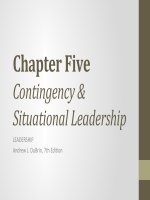Chapter 05 leadership research findings practice and skills 7th edition
Bạn đang xem bản rút gọn của tài liệu. Xem và tải ngay bản đầy đủ của tài liệu tại đây (1.42 MB, 28 trang )
Chapter Five
Contingency &
Situational Leadership
LEADERSHIP
Andrew J. DuBrin, 7th Edition
Learning Objectives
• Describe how the situation influences the choice of leadership
objectives.
• Present an overview of the contingency theory of leadership
effectiveness.
• Explain the Path-Goal Theory of leadership effectiveness.
• Explain Situational LeadershipR II (SLII).
• Use the Normative Decision Model to determine the most
appropriate decision-making style in a given situation.
• Explain the basics of leadership during a crisis.
• Explain how evidence-based leadership can contribute to contingency
and situational leadership.
Situational Influences on
Leadership Behavior
• Situations can influence the leadership behavior or style a
leader emphasizes.
• This contingency approach to leadership implies leaders are
most effective when they make their behavior contingent on
situational forces, including group member characteristics and
the internal and external environment surrounding the
leadership situation.
Role of Situations in Leadership
• Research has shown the following regarding the role of situations in
leadership effectiveness:
• Organizational leadership is affected by situational factors not always
under control of the leader.
• Situations shape how leaders behave.
• Situations influence the consequences of how leaders behave.
• Organizational structure and design influence which approach to
leadership is likely to be most effective.
Leadership Situational Models
• Fiedler’s Contingency Theory
• House’s Path-Goal Theory
• Hersey & Blanchard’s Situational LeadershipR (SL II)
• Vroom & Jago’s Normative Decision Model
• Leader-Member Exchange (LMX)
Fiedler’s Contingency Theory
• The basic idea is simple:
• Match the leader’s style with the situation most favorable for his/her
success.
• The theory was designed to enable leaders to diagnose both leadership
style and organizational situations.
• Leadership style may be relationship- or task-motivated.
• Leadership style is relatively enduring and difficult to change.
• Leaders are regarded as having a consistent style of task or relationship
orientation.
• Leaders should be matched to situations according to their style.
Least Preferred Coworker
- LPC Scale
• The LPC scale measures the degree to which a leader
describes favorably or unfavorably an employee with whom
he or she could work least well.
• Not the coworker you LIKED least, but the one you had
the most difficulty getting a job done with.
• A relationship-motivated leader tends to describe their LPC
in favorable terms.
• A task-motivated leader tends to describe their LPC in
unfavorable terms.
Measuring the Leadership
Situation
• Leadership situations are classified as High, Moderate, or Low
control.
• More controllable situations are viewed as more favorable for the
leader.
• Control is determined by three dimensions:
• Leader-Member Relations
• Task Structure
• Position Power
Summary of Findings From
Fiedler’s Contingency Theory
Evaluating Fiedler’s Theory
• Fiedler’s work did prompt others to conduct studies about the
contingency nature of leadership.
• Fiedler’s model/theory did alert leaders to the importance of
sizing up the situation when working to gain control.
• However, Fiedler’s Contingency Theory was found to be too
complicated to have had much of an impact on the majority of
leaders.
Path-Goal Theory
• Developed by Robert House
• Specifies what a leader must do to achieve high productivity and morale
in a given situation.
• In general, the theory says a leader who attempts to “clear the path” to
a goal for a group member tends to find the group member’s job
satisfaction and performance increase.
• A leader should choose a leadership style that takes into account the group
member characteristics and the task demands.
• The theory is based on the Expectancy Theory of Motivation.
Path-Goal Theory
Using Path-Goal Theory to Match
Leadership Style to Situations
• DIRECTIVE
• Tasks are unclear
• SUPPORTIVE
• Tasks are frustrating and stressful, plus group members are
apprehensive
• PARTICIPATIVE
• Tasks are non-repetitive and group members are capable and
motivated
• ACHIEVEMENT-ORIENTED
• Tasks are unique or entrepreneurial and group members are
competent and committed
Evaluating Path-Goal Theory
• The basic tenets of the theory are on target.
• Any comprehensive theory of leadership must include the
idea that a leader’s actions have a major impact on the
motivation and satisfaction of group members.
• The theory, however, has never attracted much interest from
leaders or managers.
Situational LeadershipR (SL II)
• Developed by Kenneth Blanchard and colleagues.
• Primary focus is on the characteristics of group members – and – matching leadership
style to those characteristics.
• SLII is designed to increase the frequency and quality of conversations about
performance and professional development between leaders and group members so
that:
• Competence is developed.
• Commitment takes place.
• Turnover among talented group members is reduced.
• SLII is particularly applicable to front-line leaders, such as supervisors and team
leaders.
Basics of SLII
• The basis for effective leadership is managing the relationship
between a leader and a group member on a given task.
Basics of SLII
• Effective leadership depends on two independent behaviors:
• Supporting Behaviors
• Listening
• Giving Recognition
• Communicating
• Encouraging
• Coaching
• Directing Behaviors
• Giving Explicit Directions
• Controlling
• Supervising
• Ruling
• Regulating
Evaluating SL II
• Represents a consensus of thinking about leadership behavior in relation to group
members.
• No one style is best.
• An effective leader uses all styles, depending on the situation and the individual group
member.
• Is challenging to apply SLII consistently because leaders must “stay tuned” and tasks shift
rapidly.
• However, the model has become a basis for leadership training as the model builds on
other explanations of leadership that emphasize the role of task and relationship
behaviors.
Normative Decision Model
• See Figure 5-5 in Book on page 156
• Leaders must choose a style that elicits the correct degree of group
participation when making decisions.
• Views leadership as a decision-making process where the leader
examines the elements involved in the situation in order to determine
the most effective decision-making style.
• Model includes:
• Five decision-making styles
• Seven situational factors
Decision-Making Styles
What differs is the degree of group member participation
• Decide
• Leader makes decision alone and announces it
• Consult (Individually)
• Leader works with each group member individually to gather their suggestions – and
makes decision alone
• Consult (Group)
• Leader works with group members as a group in a meeting, gathers suggestions – and
makes decision alone
• Facilitate
• Leader presents problem to group, facilitates discussion, gathers input, ensures they
don’t favor their individual decision
• Delegate
• Leader permits group members to make the decision, works behind the scenes, does
set limits but allows group members to work autonomously
Contingency/Situational
Factors
• Decision Significance to the success of a project or the organization
• Importance of Commitment of the team to the decision
• Leader Expertise and knowledge in relation to the problem
• Likelihood of Commitment of the team to a decision if the leader
makes the decision on his/her own
• Group Support of the team in relation to the organization’s objectives
at stake in the problem
• Group Expertise of the team members in relation to the problem
• Team Competence of the team members ability to work together in
solving problems
Evaluating the Normative
Decision Model
• Has been shown to lead to increased decision-making effectiveness.
• Leaders who consistently use the model are typically seen to be
more effective leaders in that they have increased the effectiveness
of their decision making.
• Assessing the situational factors can be challenging – and – typically
relies on intuition and distorted thinking.
• Using the model requires much time.
• Model does not deal with charismatic or transformational
leadership.
Leader-Member Exchange
(LMX)
• Another perspective on the contingency approach.
• Leaders who adapt their style to different individuals within
the group, or have different quality relationships with
individual group members, are essentially practicing
contingency leadership.
LMX Conclusions
• Leaders tend to give members of their in-group more favorable
performance ratings than they give to out-group members,
even when objective performance is the same.
• Leaders do not always develop entirely different relationships
with each group member, but may respond the same way to a
few members of the group.
• Larger groups tend to result in differences with respect to
leader-member exchanges.
• Managers are more likely to use servant leadership in groups
with whom the leader has high-quality exchanges.
• Leaders are more likely to use empowerment with group
members with whom they have high-quality exchanges.
Leadership During a Crisis
• Crisis leadership is the process of leading group members through a
sudden and largely unanticipated, intensely negative, and
emotionally draining circumstance.
• Be decisive
• Lead with compassion
• Reestablish the usual work routine
• Avoid a circle-the-wagons mentality
• Display optimism
• Prevent the crisis through disaster planning
• Provide stable performance
• Be a transformational leader









